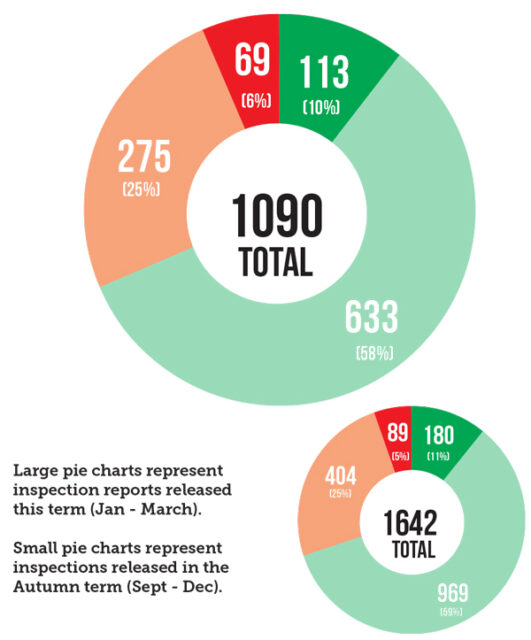As another term draws to a close, Schools Week takes a look at what Ofsted has been up to since Christmas
Overall grade distribution
We published our first Ofsted inspection analysis at the end of the autumn term, as a quick and easy way to keep an eye on inspection outcome trends at all levels and across different types of schools.
There were fewer inspections this term: 1,090 compared with 1,642 at the end of the autumn term.
Just over two-thirds of schools (68 per cent) were rated as either good or outstanding, a similar picture to before Christmas.
No school moved from inadequate to outstanding this term. But, again, copying last term’s pattern, more went up at least one grade than fell – 315 versus 202.
The biggest proportion of schools stayed at the same grade.
![]()


Primaries vs. secondaries
The primary sector once again outperformed their counterparts. Overall, 71 per cent of primary schools were rated as either good or outstanding; less than half of secondary schools inspected met the same measure.
Four per cent of primary schools were placed in special measures, compared with 15 per cent of secondary. There are some high-profile cases within this group.
Last time we did this analysis, chief inspector Sir Michael Wilshaw raised concerns in Ofsted’s report that improvement in secondary schools had stalled. If this term’s results are anything to go by, he could have a point.
Alternative provision schools had the best overall outcomes last time, but this term Denewood Learning Centre in Nottingham went from good to inadequate. It was told it was not managing the behavioural problems of a “significant number” of pupils, with teachers often being spat at, punched or kicked.
Special schools mirrored last term with 85 per cent rated good or outstanding.
Schools which were visited by a HMI as a lead inspector were most likely to get an inadequate rating – this happened in 37 per cent of those inspections. However, this number could alter depending on how well the information was recorded on the inspection reports, as it was not noted if an HMI was simply a member of the inspection team.

How do different school types compare?
The biggest difference this time is the picture for free schools.
Last term, all of the seven schools inspected were either good or outstanding. This term, of the five inspected, one was good and the remaining four were split evenly as being either requires improvement or inadequate.
While there have still been very few free school inspections, Durham Free School was put into special measures in January, resulting in education secretary Nicky Morgan deciding to terminate its funding last month. It was due to close today.
The Derby free school, Al-Madinah, went up from inadequate to requires improvement. Ofsted inspectors praised the new headteacher for her “clear vision”.
There was just 1 per cent difference between maintained schools and converter academies (which have to be good or outstanding to gain academy status). Maintained schools tipped the balance with 70 per cent getting good or outstanding outcomes, compared with 69 per cent for converters.
Sponsored academies mirrored their performance last term with more than half (55 per cent) requiring improvement or deemed inadequate.

Parents’ concerns about safety were ‘justified’
No school jumped from inadequate to outstanding – although six did the opposite.
Safeguarding is a hot topic for the inspectorate. The Trojan Horse allegations of an “extremist plot” in Birmingham, and a review of Ofsted’s failings in the case of a girl who was allegedly sexually assaulted at Stanbridge Earl, an independent boarding school for children with special educational needs, both sparked a renewed focus on children’s safety at school.
In this context, it is notable that one Cheshire primary school was downgraded from the top grade to special measures after a visit in February. Inspectors criticised Bunbury Aldersey CE Primary School after concerns raised by parents.
Ofsted said its no-notice inspection was scheduled for a single day, but a second inspector was quickly drafted to join for a second day.
During the inspection the school was undergoing building work. Ofsted noticed safety issues and labelled the school’s ability to keep pupils safe as “inadequate”.
The report said: “Leaders have not ensured they have access to important risk assessments including those carried out by external agencies working in the school.
“This means they have been unable to put into place measures to reduce potential of risk.
“Furthermore, leaders’ in-school assessments do not address fully the potential dangers to pupils including when playing football around cars parked on the playground, for instance. While this risk was removed by the second day of the inspection, pupils had already become used to playing in such situations.”
Inspectors said adult supervision during break and lunchtimes at the primary school was not “ensured” and not all staff had received safeguarding training. Some parents had not been made aware of incidents involving their children.
“Nearly half the parents who responded . . . were not confident their children were safe at school. Concerns expressed are justified.
“The measures taken by leaders and governors to ensure the safety of pupils are not robust enough.
“During the inspection, for example, pupils were spotted retrieving footballs from underneath cars or running round while eating food, often without challenge.”
Despite concerns with safety, behaviour and leadership, the school was rated as good for its quality of teaching, achievement of pupils and early years’ provision.
The inspectors praised the achievement of pupils and teaching, and said during class children were “polite, courteous and listen to adults and each other very well”, but this behaviour was not mimicked outside lesson time and that pupils’ social development was, therefore, less well developed than their moral and cultural development.
The school did not respond to Schools Week when asked for a comment.
Notes:
Based on all section 5 school inspection reports published between January 1 and March 20
Data provided by Watchsted, a service from Angel Solutions Ltd
Percentages may not sum to 100 due to rounding
1. Converter academies are treated as not having been inspected previously where this inspection was as a maintained school
2. Consisting of studio schools, pupil referral units, foundation schools and non-maintained special schools








Thanks for including special schools